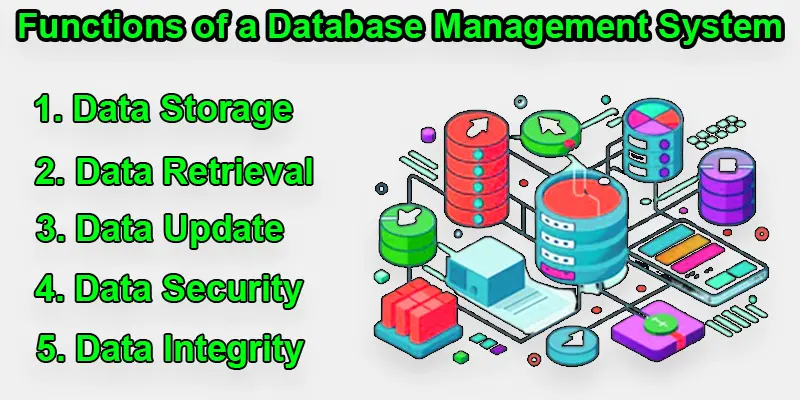Functions of the DBMS
Published: 24 Sep 2024
Functions of DBMS
A Database Management System (DBMS) is like a smart organizer for handling large amounts of data. It helps store, manage, and retrieve data efficiently while keeping it secure and accessible to multiple users. The DBMS ensures that data is accurate, can be easily updated, and follows specific rules. It also provides ways to recover lost data and handle multiple tasks at once, making it an essential tool for managing information in businesses, websites, and applications.
Functions of a Database Management System
The functions of a Database Management System (DBMS) encompass a range of essential tasks that promote efficient data management.

Data Storage
Data storage in a DBMS means keeping all your information in one place in an organized way. It’s like a digital filing cabinet where you can store large amounts of data, such as names, addresses, or transaction details. The DBMS arranges this data so that it’s easy to find and use whenever needed, saving you time and effort. It ensures your data is safe and ready for quick access.
Data Retrieval
Data retrieval in a DBMS is the process of finding and getting the information you need from the stored data. It’s like searching for a file in a big library, but much faster. You can ask the DBMS to search for specific details, like a name or an order number, and it will quickly show you the exact data you’re looking for. This makes it easy to access the right information without going through everything manually.
Data Update
Data update in a DBMS means making changes or corrections to the stored information. It’s like editing a document to keep the details current and accurate. Whether you need to change an address, update a price, or correct a mistake, the DBMS allows you to easily find and modify the data. This ensures that your database always has the latest and most accurate information.
Data Security
Data security in a DBMS is about keeping your information safe from unauthorized access or changes. It works like a digital lock, allowing only trusted people to view or edit the data. By setting up passwords and permissions, the DBMS ensures that sensitive information is protected from hackers or accidental changes, helping to keep your data private and secure.
Data Constraints
Data constraints in a DBMS are rules that ensure the data entered into the database is correct and meaningful. It’s like setting guidelines, such as making sure phone numbers only contain digits or that every email address has an “@” symbol. These constraints prevent mistakes by ensuring the data follows the right format and stays consistent. This helps maintain accuracy and reliability in the database.
Data Integrity
Data integrity in a DBMS ensures that the information in the database is accurate, complete, and reliable. It’s like making sure everything stays in order, with no duplicate records or missing details. Data integrity checks that the data is consistent and correct over time, even when multiple changes are made. This helps maintain trust in the accuracy of the database.
Concurrency Control
Concurrency control in a DBMS ensures that multiple people can use the database at the same time without causing problems. It’s like several people working on a shared document, but the DBMS ensures everyone’s changes are correctly handled. This prevents conflicts, such as two users accidentally editing the same data in a way that could cause errors, ensuring everything runs smoothly even when many users are working at once.
Transaction Management
Transaction management in a DBMS ensures that all changes made to the database are completed properly and safely. It’s like making sure a series of steps, such as transferring money from one account to another, happen smoothly and fully. If something goes wrong in the middle, transaction management ensures that the database goes back to its original state, preventing any partial changes or errors. This keeps data accurate and reliable.
Data Backup and Recovery
Data backup and recovery in a DBMS is about creating copies of your data to keep it safe in case something goes wrong. It’s like making a photocopy of important documents so you don’t lose them. If there’s a system failure, accidental deletion, or any other problem, you can quickly restore your data from the backup. This process helps ensure that your information is protected and can be recovered whenever needed.

Data Transformation and Presentation
Data transformation and presentation in a DBMS involve changing the data into a useful format and displaying it in an easy-to-understand way. It’s like taking raw ingredients and cooking them into a delicious meal. The DBMS processes the data, organizing and summarizing it, so users can see trends, reports, or charts. This makes it simpler to analyze and make decisions based on the information.
Conclusion about Functions in DBMS
A Database Management System (DBMS) plays a crucial role in managing data effectively. Its functions, such as data storage, retrieval, updating, and security, ensure that information is accurate, safe, and easily accessible. By handling multiple users, maintaining data integrity, and allowing for backups and recovery, a DBMS helps businesses and applications operate smoothly. Overall, it makes managing large amounts of data easier and more efficient, supporting better decision-making and productivity.
FAQS – Functions DBMS
What is the function of DBMS?
The function of a DBMS is to organize and control access to data in a database. It helps store information safely, allows users to easily find and update data, ensures data accuracy and security, and supports multiple users working simultaneously. Overall, it makes handling large amounts of data more efficient and reliable.
How many tasks can DBMS perform?
A DBMS can perform several important tasks, typically around ten key functions. These include data storage, retrieval, updating, security, backup and recovery, data integrity, data constraints, transaction management, concurrency control, and data transformation and presentation.

- Be Respectful
- Stay Relevant
- Stay Positive
- True Feedback
- Encourage Discussion
- Avoid Spamming
- No Fake News
- Don't Copy-Paste
- No Personal Attacks

- Be Respectful
- Stay Relevant
- Stay Positive
- True Feedback
- Encourage Discussion
- Avoid Spamming
- No Fake News
- Don't Copy-Paste
- No Personal Attacks





